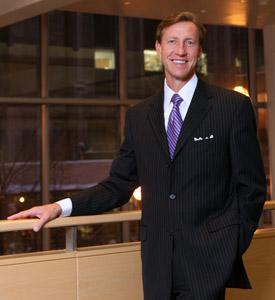 |
|
Dean J. Larry Jameson |
Challenges and Opportunities for the Feinberg School
Drawing parallels between the nation’s and the medical school’s economic challenges and the opportunities they present, Dean J. Larry Jameson, MD, PhD, vice president for medical affairs and Lewis Landsberg Dean of the Feinberg School of Medicine welcomed a standingâroomâonly crowd to the 2009 State of the School address held recently in the Hughes Auditorium of the Robert H. Lurie Medical Research Center.
The Finances
“We are relatively well off financially at present,” said the dean. He credited the administration’s careful planning over many decades, limited use of debt for capital projects, and less reliance on the endowment for liquidity and cash flow compared to other institutions with our healthy economic affairs.
Given the nature of endowments, however, that will change, he said, since the payoff that we are experiencing now is part of a rolling average of previous years. “The economic impact of this year will be felt in the future,” he noted. Department chairs and center directors are working with the financial departments at the medical school, hospitals, and university to address these difficult issues.
“But these challenging issues also create opportunities,” the dean said. “As we are either replacing faculty or strategically investing in certain areas, we can be highly selective in a time when other people are having reductions or no ability to grow or replace at the same time.”
Adding to the economic challenge is the continued flattening of research funding from the National Institutes of Health. The dean encouraged researchers to continue to develop “great ideas” and submit grant applications for new research as well as seek renewal of existing grants.
The People
Moving on the people who make up the Feinberg School, the dean described the student body as “fabulous” noting increases in medical school applications as well as student grade point averages and medical school admission test scores. Raising more money for scholarships and competing for students with top 10 medical schools outside the Midwest will be future priorities.
With the ending of the school’s affiliation with Evanston Northwestern Healthcare on July 1, all residents will be sponsored by Northwestern Memorial Hospital or Children’s Memorial Hospital. New affiliations with community-based hospitals will also offer opportunities to residents.
Profiles of outstanding students, faculty, and staff members personalized the dean’s message that everyone at the Feinberg School contributes to its success. “For everyone in the room, everything that you are doing is making a difference whether you are on the front line in clinical care, whether you are studying as part of the next generation and will have a career in medicine or science, or whether you are one of the staff who work here and support some of these activities—you are making a difference,” he said.
The Programs, Goals, and Guiding Principles
Illustrating the type of innovative interdisciplinary learning that exists at Northwestern, a video explaining the NUvention program was shown. In this course, students from the business, law, engineering, and medical schools work together to generate new ideas to solve existing problems.
Dean Jameson recognized the several new institutes and centers started within the medical school including the Northwestern Comprehensive Center for Obesity, the Brain Tumor Institute, the Center for Global Health, and the Comprehensive Transplant Center.
The school’s guiding principles of alignment, innovation, and impact were also addressed, calling for an alignment of institutions and University departments with one another; the carry over of innovative thinking into clinical care, basic research, clinical research, and education; and effectiveness in using our time and resources.
“The school’s commitment to delivering exceptional care, advancing medical science, and developing people, culture, and resources continues,” Dean Jameson said. “Ultimately the goal of this plan is to be a top 10 hospital and top 10 medical school by 2020,” he added. “It’s an ambitious set of goals and we think we can get there.”






